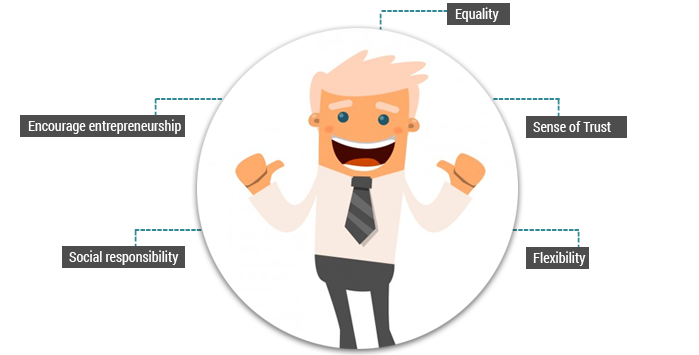This year, Finland grabbed top position in the list of world’s happiest countries, followed by Norway, Denmark, Iceland and Switzerland.
On March 14th, 2018, the Sustainable Development Solutions Network for the United Nations released the World Happiness report giving top ranks to the happiest countries in the world. According to the report, countries were ranked on multiple variables, like freedom, trust, well-being, social support, healthy life expectancy, corruption and generosity.
Over the past two decades, Happiness Quotient has been varying dramatically in some countries. Let’s talk about Denmark. Danish employees have made headlines for past many years for having amazing, stress-free work life. Denmark is a small country of 5.8 million residents, still it ranks above the average in several dimensions, such as work-life balance, skills, jobs and earning. This country has been consistently ranking in top 5 positions for having loyal and happy employees. Danes lead happy personal as well as professional life.
A Gallup report suggests that Unhappy (disengaged) Employees cost as much as $550 billion every year to U.S. companies.
Happiness at workplace matters. Its absence may negatively impact employee productivity, morale, performance, and overall business outcomes. Companies with satisfied workforce outperform those with dissatisfied staff by up to 202 percent.
Happiest Countries in the World
In an Annual Happiness Index released by Universum, more than 200,000 young professionals in 57 markets were surveyed on the following factors to determine their happiness –

- Satisfaction level in their jobs.
- Willingness to recommend a current employer.
- Chances of switching job soon.
Top 10 positions were taken by countries in Western Europe and the European Union. Unfortunately, the United States and the United Kingdom did not make even in the top 20.
Here are some facts:
Denmark — The country has been consistent in maintaining its position in top 5. Employee happiness is a top priority for employers in Denmark. Happy work culture keeps high motivation levels among workforce. Along with work life balance, social security and positive work culture, Danish work culture also offers equality to everyone. Companies with more than 35 employees open seats on the board to employees who can own them and enjoy the same power as anyone else in the top management team would do. {Source}
Norway – Best known for job security and earnings in the OECD’s Better Life Index.
Sweden – Obsessed with work-life balance, Sweden employers have experimented to have 6-hour workdays for 2 years. We are not exaggerating, but during those two years, employee engagement was on highest peak.
Canada – Majority of employees (up to 76 percent) are either ‘satisfied’ or ‘very satisfied’ with their jobs. Employment laws are structured carefully to avoid discrimination, set safety standards, minimum wages and hours of week.
Panama – Employees aren’t overworked. Two-hours long lunch break and 30 days paid vacation keep employees satisfied. If this isn’t enough to keep employees motivated and engaged, then we don’t know what is.
Austria – Employees are offered high salaries, along with 13 bank holidays and up to 5 weeks of paid holiday. Flexible maternity leave is a boon for female employees. They can avail pre-maternity leave starting from 28th week of pregnancy and 8 weeks after the child birth.
How to Increase Happiness Index?
Though each country (and workplace for that matter) has its own lifestyle and challenges, there is always a hope. If employee happiness is constantly dropping and the business outcomes aren’t satisfactory, it’s time to learn some lessons. Here are few suggestions that can be implemented to increase workforce happiness and unlock employee’s potential-

- Equality – As reports suggest, the Danish look for equality even at the workplace. People don’t believe in showing off wealth, as it’s seen negatively. In fact, salaries are evenly distributed among employees and social classes are almost inexistent.
- Sense of Trust – Employers believe in accountability and ownership of work. They give employees the freedom to take initiatives, work on their own, make mistakes and learn from them. After all, failures are the stepping stone to success. Employees trust on each other and appreciate the quality of taking initiatives. With the help of online HR tools, processes are transparent. All stakeholders remain informed on progress of individual and team goals.
- Flexibility – Employers encourage flexible office rules. Whether it concerns work hours, work-from-home or leaving early for a personal task, employees are given flexibility. Use of HR tools makes it easy for record in-and-out time, break time and short leaves. It is a win-win for employees as well as employers.
- Social responsibility – Many European companies consider it as their responsibility to fight social exclusion. Employers don’t disregard people from different social backgrounds and treat everyone with respect.
- Encourage entrepreneurship – Entrepreneurial spirit is always encouraged; in fact, people are trained to develop skills right when they start schooling. From an early age, children are encouraged to express their creativity and take their own decisions to develop self-confidence and take initiatives. High schools and universities have mandatory programs that offer lessons on innovation and entrepreneurship.


